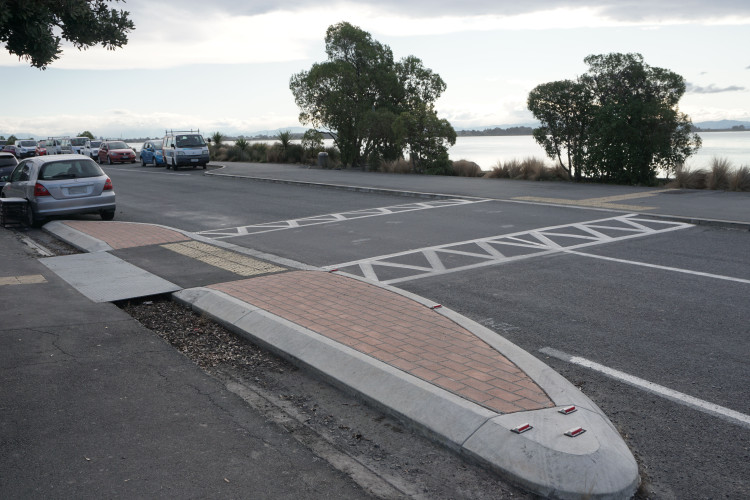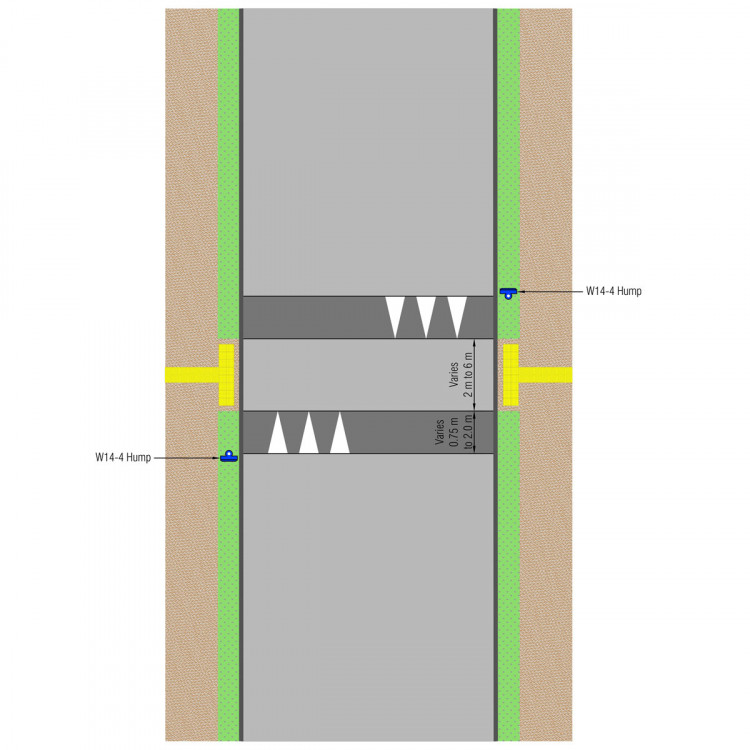Pedestrian platforms, also known as raised tables, are crossing aids for pedestrians raised above the carriageway level. They can be a raised safety platform to reduce vehicle speeds with the secondary benefit of providing a crossing place for pedestrians. They generally have a flat top and sit flush with the kerbs. On their own they provide a focus for pedestrians to cross, however pedestrians must still give way to vehicles. An example of a pedestrian platform is shown in the photo below.

Pedestrian platform, Christchurch. (Photo: Ben Jassin) Note: shows old zig zag markings.
Pedestrian platforms can support other forms of control such as zebra crossings and signalised crossings.
|
Courtesy crossing |
Pedestrian platform |
|
|
 |
|
Courtesy crossings are intended to facilitate eye contact between pedestrians and drivers resulting in a mutually negotiated position over who goes first. |
On their own pedestrian platforms provide a focus for pedestrians to cross, however pedestrians must still give way to vehicles. |
|
Traffic volume less than 7500vpd (could be higher if a median refuge is provided and an alternative crossing provided nearby) |
Traffic volumes less than 3000vpd |
|
Vehicle operating speeds very low, at most 30km/h, ideally 20km/h or less. The lower the speed the more effective the crossing as vehicles are going to slower so are more likely to be courteous to pedestrians wishing to cross. |
Vehicle operating speeds less than 50km/h (the platform should be designed to slow vehicle speeds to 30km/h) |
|
Likely to be found on Activity Streets, Main Streets and Civic Spaces where pedestrian volumes are high |
Likely to be found on Local Streets and Activity Streets where the pedestrian volumes are low |
|
Ideally on a platform with steep approach ramps to reduce vehicle speeds |
On a platform with approach ramps to reduce vehicle speeds |
|
Crossing colour/texture should contrast with the road and footpath to indicate both users are guests over the crossing |
Crossing colour/texture should contrast with the footpath to indicate that pedestrians do not have priority and ideally be the same material as the road. |
Check whether a pedestrian platform is a suitable treatment for your site by referring to:
PNG: Crossing selection guidance
Pedestrian platforms can be combined with other elements:
Platforms can be installed to guide pedestrians to a place at which to cross a roadway. A platform on its own does not require a driver to stop their vehicle while a pedestrian crosses the roadway (TCD Rule, 8.1(2)).
The rule also imposes obligations to ensure the platform:
Land Transport Rule: Traffic Control Devices 2004
It is important that pedestrians identify they are do not have priority on a pedestrian platform, so there must be a clear demarcation between the road and the footpath in the following ways:
Platforms must either be flush with the footpath (so no kerb ramps necessary) or the transition between the footpath and the platform must provide for the smooth passage of all pedestrians including those using small wheels. It is noted that at some existing pedestrian platforms the edges taper to the drainage channels however these are generally not desirable for pedestrian crossing locations.
Bollards or other access control devices should not be used where they would restrict access by mobility devices or create a tripping hazard.
Signs such as ‘Pedestrians watch for vehicles’, ‘Pause’ or ‘Pedestrians cross with care’ have been installed at some platforms although these are not necessary or recommended if there is a clear demarcation between the platform and the footpath.
Drivers should be made aware of a pedestrian platform in good time so they are able to reduce their speed, for example they should not be located immediately after a sharp bend. Markings are also required on the approach ramps as the driver’s view of the top of the platform is restricted.
Pedestrian platforms must adopt a flat top profile. The recommended approach ramp grades to achieve Safe System impact speeds are detailed in the table below. These grades optimise the likelihood of vehicles slowing to the desired speed on the approach to a pedestrian platform. Easing of ramp grades below the values listed may be considered to accommodate certain road users, such as heavy vehicles, emergency vehicles, buses or bicycles. However this needs to be balanced against the impact if the majority of users are able to traverse the platform comfortably thus reducing its effectiveness.
The table below outlines the design elements for pedestrian platforms and the figure below shows a typical layout for a pedestrian platform.
Table: Design elements for pedestrian platforms
|
Element |
Requirement |
Additional information |
|
Platform height |
100mm recommended |
75mm may be considered where site constraints and traffic composition suggest a lower height profile is suitable (i.e. high truck volume routes) 150mm may be considered for low speed (<50km/h) and low traffic volume environments. |
|
Platform length |
Minimum length 2m, maximum length 6m. |
|
|
Approach ramp gradient |
At least 1:15 for 30km/h platform speed, steeper ramps are more effective in slowing vehicle speeds. 1:20 for 40km/h platform speed or 1:25 for 50km/h platform speed but these are not safe system compliant for pedestrians crossings.. |
Ramp grade should be designed to achieve the required Safe System impact speed prior to entering the conflict point. Steeper ramp gradients are more effective in lowering vehicle speeds over the platform. |
|
Departure ramp gradient |
Maximum 1:35 |
Where the platform is located on an undivided carriageway, the departure ramp gradient will be the same as the approach ramp gradient. |
|
Ramp markings |
The face visible to approaching drivers should be marked with hump ramp markings. |
Further information can be found in the |
|
Surfacing / colour |
The platform surface should be clearly distinguishable from the footpath and ideally the same material as the road. |
Also refer to Roadway art guidance found in the |
|
Tactile indicators |
Warning indicators are required and directional indicators may be necessary. |
Further information is provided in |
|
Signage |
W14-4 Hump warning sign as per |
|
|
Lighting |
In accordance with AS/NZS 1158.3.1: 2020 |
Further information can be found in |

A typical layout of a pedestrian platform.
A wide variety of surfacing material can be used on pedestrian platforms, however they must:
[1] Corben, B. (2020). Integrating Safe System with Movement and Place for Vulnerable Road Users(external link), Austroads, AP-R611-20, p19